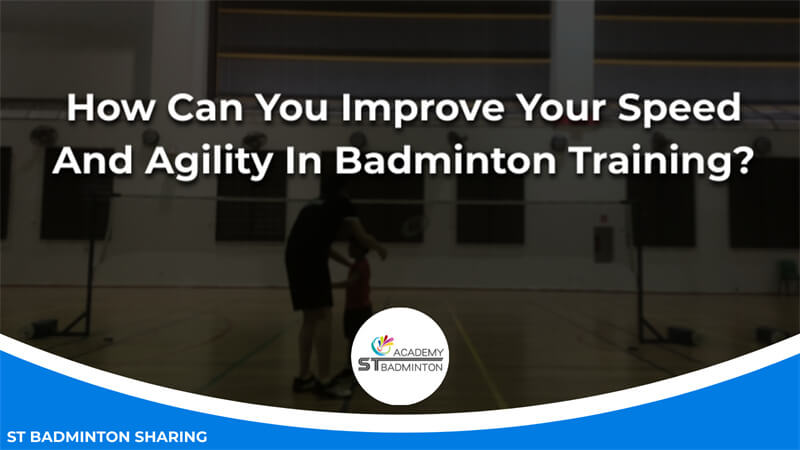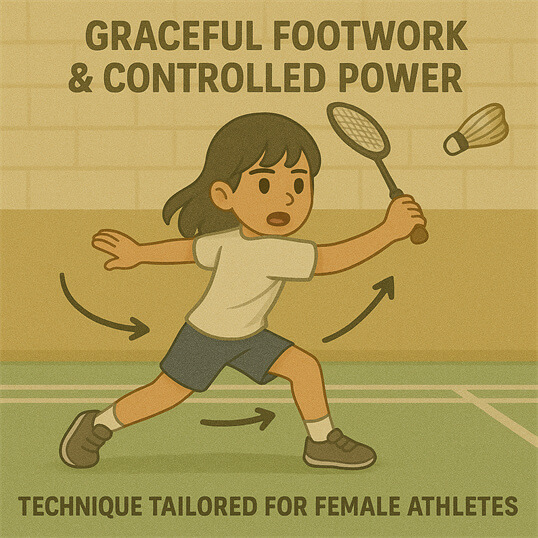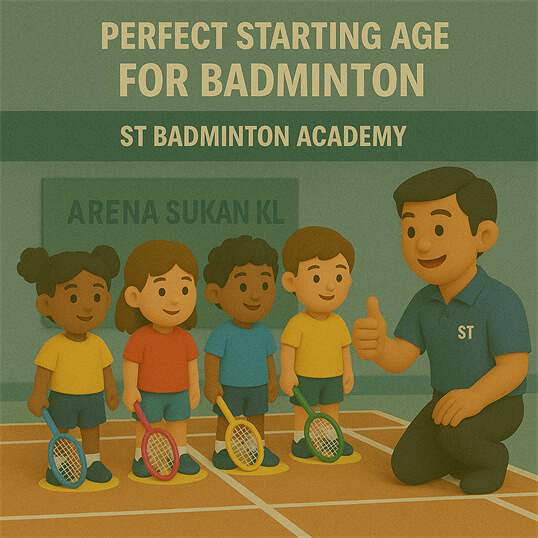Welcome to ST Badminton Academy’s badminton training in Malaysia! Hi there, I’m Coach Eric and I’m a badminton performance coach. If you’re looking to improve your speed and agility in badminton training then you’ve come to the right place!
Speed and agility are important components of any successful badminton game – so it’s important that athletes focus on developing these skills if they want to succeed. In this article, I’ll share some tips for how you can step up your speed and agility in training. Let’s get started!
Warm-Ups And Dynamic Stretches
As a badminton performance coach, I always prioritize warm-up and dynamic stretching exercises to ensure that my players are ready for any upcoming speed or coordination drills. A great starting point is to perform light movements such as jogging in place and leg swings. This helps activate the muscles throughout the body while gradually increasing heart rate and breathing rate.
Once these basic movements have been completed, I introduce more targeted stretches focused on working the entire lower body muscle groups used during speedy movement patterns in badminton. For example, lunges with a twist, squats with an overhead reach, and single-leg half-kneeling hip flexor stretches will prepare your legs for maximum power output when you start doing those speed drills!
To get ready for coordination drills, it’s important to practice simple agility patterns like lateral shuffles, carioca steps, and jumping jacks. All of these exercises help improve balance and stability which is key if you want to move quickly around the court without sacrificing accuracy or control.
By incorporating them into your training routine regularly your footwork will become much sharper. With improved flexibility and mobility comes better technique which ultimately leads to faster reaction times in competitive matches – something every player should strive for!
Plyometric Training
It takes a lot of hard work and dedication to become an agile badminton player. However, with the right training, you can achieve great speed and agility in no time. Think of it like a puzzle – if all the pieces are put together through plyometric exercises, body weight drills, and speed drills then your performance will be top-notch. Other than choosing a good racket and also remember to choose the best racket restring in Malaysia.
Plyometrics is one way to boost your speed and agility for badminton. Here’s how:
| # | Action |
|---|---|
| 1. | Increase power output by increasing muscle elasticity |
| 2. | Improve muscular coordination between agonist and antagonist muscles |
| 3. | Enhance aerobic capacity by doing multiple jumps |
| 4. | Improve balance and stability when landing on the court after jumping |
The key to improving your speed and agility is performing explosive movements that condition both neuromuscular systems as well as enhance physical strength.
By consistently engaging these types of exercises into your workout routine, you will notice significant improvements in your gameplay – making every shot that much better! With this newfound knowledge, you’ll be equipped with the tools necessary to transition into more advanced agility ladder exercises.
Agility Ladder Exercises
I’m a big believer in agility ladder drills for improving your speed and agility on the court. It’s essential to incorporate these exercises as part of your badminton training program, along with strength training and skill development activities.
Agility ladders are great because they get you used to quick changes in direction, which is an important factor when it comes to success in badminton. They also help improve coordination, balance, and footwork while challenging both your aerobic capacity and muscular endurance. Plus, using an agility ladder can be fun – there are plenty of creative ways to vary up your routine so that it doesn’t become too boring.
By doing agility ladder drills regularly, you’ll most certainly see improvements in your overall performance on the court. You’ll have increased coordination between body movements and improved reaction time when switching directions or changing pace during rallies.
So make sure to dedicate some time each week towards getting faster and more agile by incorporating agility ladder exercises into your practice sessions! The time now to move on to footwork drills where we can take our game up another level!
Footwork Drills
No one ever said being a badminton player was easy. It takes speed, agility, and precision to make it to the top of your game. To get there you must practice drills that will help build those skills. Starting with footwork drills is the key to success!
First up on our list are jump rope exercises. Jumping rope not only builds cardio but also helps build coordination and agility in both feet as well as quickness. Not to mention, skipping ropes come in all shapes and sizes so finding what works for you won’t be too hard.
Next on the docket are agility drills. Agility ladders or cones can be used for many different kinds of drills such as shuffles, jumps, side steps, etc.. Doing these regularly will increase your muscle memory and help build endurance over time. So don’t skimp out on this part either – it’s just as important!
Now that we have taken care of building speed and agility through jump ropes and ladder/cone exercises, let’s move on to lateral movement exercises to finish off our workout session.
Lateral Movement Exercises
I’m sure you know that lateral movement and agility is an important parts of badminton. To improve your speed and agility, I recommend adding jumping drills to your training regimen.
These exercises will help you move quickly on the court, while also building up your leg muscles for more powerful shots. For example, try doing a series of jumps back and forth across the court with no pauses in between. This drill should be done at full intensity, so don’t forget to focus on proper form!
Another great way to increase your agility is by incorporating court sprints into your routine. Start from one baseline corner of the court and sprint diagonally all the way up to the opposite service line before turning around and repeating this pattern until you reach the other end of the court.
You can make it even more challenging by increasing the height or distance of each jump as you go along. Doing these drills regularly will strengthen both your lower body muscle groups and cardiovascular system, helping you become quicker on the badminton court.
Of course, improving speed isn’t just about mastering those quick movements – cardio and endurance training are key components too. So let’s take a look at how we can build our aerobic capacity…
Cardio And Endurance Training
Let’s get ready to improve your speed and agility in badminton training! To get the best results, you should start with a good warm-up routine. This should include dynamic stretching and light cardio to get the heart rate up.
Once you’re warmed up, then you can start your interval training. This includes short bursts of intense activity followed by brief rest periods. And don’t forget about strength training. Incorporating core and upper body exercises into your routine will help your badminton performance. So, let’s get started!
Warm-Up Exercises
Before hitting the court for intensive badminton training, you must warm up your body and mind. Warming up is essential to prepare you physically and mentally for a great game of badminton. As your coach, I suggest starting with basic cardio exercises like jogging or skipping rope to get your heart rate going and get some blood flowing into your muscles. This will help increase flexibility and prevent any potential injuries during practice.
Next, it’s important that we focus on developing body awareness and agility drills to improve speed and agility throughout the session. Incorporating agility ladder drills as well as dynamic stretching can really help improve reaction time while also testing coordination levels in different directions.
Additionally, using cone drills or hurdle hops are great ways to condition the body specifically for quick changes of direction or movements while playing badminton.
By having good physical conditioning through regular aerobic exercise combined with specific agility drills, will ensure that you have improved control over all aspects of movement so that your reflexes can be sharpened and put into action when needed during an intense game on the court!
Interval Training
Once you feel your body is warmed up and ready, it’s time to move on to interval training. This type of cardio and endurance training involves short bursts of intense activity with active rest periods in between. Interval timing can help push your aerobic capacity so that you are able to perform at a higher intensity level when playing badminton.
I like using reaction drills as part of this type of exercise since they really test your agility and coordination levels while also improving your speed and reflexes in different directions. You’ll be amazed by how much more explosive your movements will become after incorporating these types of drills into regular practice sessions!
With a good conditioning plan that consists of aerobic exercises along with specific agility, reaction, and interval drills, all aspects of movement control should be improved, allowing you to play badminton confidently and efficiently during an intense match.
Strength Training
Once you’ve got your cardio and agility in check, it’s time to focus on strength training. Balance work is essential for badminton players; this helps build the muscle memory needed for court movement as well as providing stability when smashing or defending shots across the court. I like using speed drills that target specific parts of the body such as static lunges which help strengthen legs and core muscles.
This type of exercise makes sure that all areas are evenly worked so none become overdeveloped while others remain weak. With regular balance and speed drills incorporated into practice sessions, a player will be able to move faster around the court with greater control. Plus they’ll have increased power behind their strokes – allowing them to dominate their opponents!
Core Strengthening Exercises
Increasing speed and agility in badminton is essential for success. To do this, core strengthening exercises are crucial to developing the necessary physical skills needed for a competitive edge on the court.
The first step is building strong balance drills. These will help you develop better body control and stability while playing your shots. Simple exercises such as standing on one foot or balancing on an unstable surface can be incredibly effective at improving coordination, agility, reaction time, and power transfer from the lower body to the upper body.
Coordinative drills are also important when it comes to improving speed and agility in badminton. This involves performing specific movements with correct technique and accuracy repeatedly over short distances with quick changes of direction. Examples include starting off with basic techniques like skipping, hopping, galloping, and side-stepping before progressing onto more complex patterns that simulate real game situations, such as shuttle runs and figure 8s.
| # | Action |
|---|---|
| 1. | Incorporate balance drills into training routine to |
| improve body control | |
| —- | ——————————————————— |
| 2. | Practice coordinative drills regularly to increase |
| speed and agility | |
| —- | ——————————————————— |
| 3. | Focus on basic movement patterns like skipping & |
| galloping, then progress to more complex ones |
Mental And Visualization Exercises
Now that we have covered core strengthening exercises for badminton, let’s move on to mental and visualization exercises. Mental discipline is essential for achieving peak performance in any sport, but especially badminton where the speed of play demands quick thinking and reaction times. As a coach, I cannot stress enough how important it is to train your mind as well as your body if you want to reach the next level of play.
| Focus | Technique | Benefit |
|---|---|---|
| Breathing | Mindful breathing | Improved focus & reduced anxiety/stress levels |
| Visualization | Picture yourself playing perfectly | Improves physical coordination during game-play |
| Attention Control | Concentrate on one point at a time | Enhances clarity while executing shots |
Here are some key techniques coaches can use with their players to develop proper mental conditioning: mindful breathing, visualization exercises, and attention control training. With mindful breathing, athletes learn to take deep breaths in order to relax their minds and refocus when faced with challenging situations or fatigue. By visualizing themselves playing perfectly before games begin, they can improve their physical coordination so that their movements become almost automatic on the court. Lastly, focusing intently on one shot at a time will help them stay sharp even against the toughest opponents.
Mental discipline and visualization techniques should be an integral part of every athlete’s practice routine if they hope to succeed in this fast-paced sport. While drills that strengthen technical skills remain necessary, honing mental toughness through regular practice sessions is equally vital if one wants to win consistently under pressure. Badminton requires both strong muscles and a powerful mind – only then can players achieve greatness!
Frequently Asked Questions

What Are The Best Shoes For Badminton Training?
As the old saying goes, ‘you can’t run a marathon in flip-flops’, and that is especially true when it comes to badminton training. As a performance coach for competitive badminton players, I always stress the importance of selecting proper footwear during training sessions.
Not only do you need shoes with good traction and stability on the court, but they must also provide adequate cushioning and support as well.
The right pair of shoes will help minimize fatigue and ensure optimal performance across multiple training frequency levels throughout your season. Selecting quality footwear is an important first step in improving speed and agility while playing badminton.”
How Long Should Each Badminton Training Session Be?
As a badminton performance coach, I recommend that your training sessions should last between 45-60 minutes. This will give you enough time to focus on skill drills such as footwork and hand-eye coordination as well as exercising for the desired duration.
Remember, it’s better to break up exercise into shorter bursts rather than one long session in order to maximize performance gains and prevent injury!
What Are Some Badminton Drills For Improving Speed And Agility?
If you’re a badminton player looking to improve your speed and agility, then the right drills are essential. As a performance coach, I can vouch that proper warmups and stretching exercises are key in boosting your overall athleticism on the court. Work with a partner or group to perform high knee marches, skips, butt kicks, and other dynamic movements.
You should also incorporate lateral shuffles with quick stops, jumps over hurdles at different heights, and running sprints for short bursts of energy. All these drills help in improving acceleration as well as strengthening muscles used during games.
Are There Any Supplements That Can Improve Speed And Agility?
When it comes to improving speed and agility in badminton, supplements can be a great addition to your training routine. However, supplement safety should always come first- make sure you understand the potential risks of any supplement you consider using. Additionally, warm-up exercises are essential for preventing injury and optimizing performance.
Stretching and dynamic drills like skips or bounding will help prepare your muscles for play while also helping with coordination and agility. So if you’re looking to get an edge over your opponents on the court, don’t forget about incorporating safe supplementation as well as regular pre-game warm-ups into your practice schedule!
Is There A Difference Between Speed And Agility For Badminton?
When it comes to badminton, there is a distinct difference between speed and agility. Speed relates to the swiftness of your movements, whereas agility involves using footwork drills and plyometric exercises to strategically maneuver around the court. As a performance coach, I constantly stress this distinction as these two elements are essential in becoming an ace player. When combined with proper technique, they can help you dominate any match!
Learn Speed And Agility in Badminton Training Malaysia
The difference between speed and agility in badminton is significant. Speed can help you get to the shuttle quickly, while agility helps you react more effectively. It’s essential for any badminton player to be able to have both attributes if they want to improve their performance. With proper training, equipment, drills, and supplements you can become a better badminton athlete faster than ever before!
I recently had the pleasure of working with an up-and-coming badminton player who was looking to increase her speed and agility on the court. We used specific footwork exercises as well as some plyometric drills that improved her reaction time significantly. After just three months she transformed from a novice into an experienced competitor who could keep up with even the best players around! She felt like she unlocked a secret superpower!





